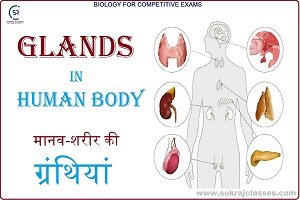
Pancreas (अग्नाशय) in Human Body – Biology Topic.
Biology Science topic -“Pancreas (अग्नाशय) in Human Body”, is important for all competitive exams like SSC CGL, SSC CHSL, RRB NTPC, UPSC and other state civil services exams. In these exams, almost 4-5 questions are coming from Biology. Let’s start the topic:- Pancreas (अग्नाशय) in Human Body:
Pancreas (अग्नाशय) and its Functions
- Organ System: Digestive System.
- Organ Location: Upper left abdomen.
- Organ Purpose: Regulate blood sugar levels.
- Organ Weight: 91.8 g (range: 40.9 to 182 g).
- Organ Length: About 6 inches.
The pancreas is 2nd largest gland of Human body. It is an organ of the digestive system. In humans, it is located behind the stomach in the upper left abdomen and surrounded by spleen, liver and small intestine and functions as a gland. It plays an essential role in converting the food we eat into fuel for the body’s cells.

- It is spongy, about six to ten inches long, and is shaped like a flat pear.
- The wide part, called the head of the pancreas. The head of the pancreas is located at the juncture where the stomach meets the first part of the small intestine. This is where the stomach empties partially digested food into the intestine, and the pancreas releases digestive enzymes into these contents.
- The central section of the pancreas is called the neck or body.
- The thin end is called the tail and extends to the left side.
The pancreas has two main functions:
- Endocrine function:
During this function pancreas acts as endocrine gland that regulates blood sugar levels. It consists of islet cells that create and release two important hormones: insulin and glucagon, directly into the bloodstream.
-
- Insulin, which acts to lower blood sugar.
- Glucagon, which acts to raise blood sugar.
- If Hyper-secretion (ज्यादा मात्रा में स्त्रावित होना) of Insulin takes place, deficiency of sugar/glucose in blood occur and it cause a disease – Hypoglycemia.
- If Hypo-secretion (कम मात्रा में स्त्रावित होना) of Insulin takes place, Sugar/ glucose level of blood increase and it cause a disease – Hyperglycemia. It is also known as Diabetes (मधुमेह रोग).
Note: The malfunctioning of Pancreases cause –Diabetes. It can control by use of Fenugreek (मैथी) in our food as it increase secretion of insulin in human body.
- Exocrine function:
It helps in digestion of food. During this function, a pancreas acts as an exocrine gland that produces Enzymes (important to digestion) which secrets Pancreatic Juice. These enzymes include: – Trypsin and chymotrypsin (Pepsin) to digest proteins; Amylase for the digestion of carbohydrates; Rennin to digest Milk and Lipase to break down Fats.
When food enters the stomach, it secretes pancreatic juice through the pancreatic duct. This juice contains bicarbonates that help to digest food.
- Pepsin + Trypsin (Protein) —> Peptone + Amino-acid.
Note : Chronic use of Alcohol causes Inflammation in Pancreas known as: Pancreatitis.
Also Read: Liver (यकृत) in Human Body- Biology Topic
Important Facts about Pancreas for competitive exams:
- The pancreas is an organ that has a flat pear-like shape.
- It is 2nd largest gland of human body.
- The pancreas is a part of the human digestive system and found in the upper left abdomen area, behind the stomach.
- The primary function of the pancreas is to regulate blood sugar levels and metabolism.
- The pancreas also aids digestion by secreting a variety of enzymes (pancreatic juice).
- Enzymes produced by pancreas
- Trypsin and chymotrypsin (Pepsin) to digest proteins;
- Amylase for the digestion of carbohydrates;
- Rennin to digest Milk.
- Lipase to break down Fats.
- High secretion of Insulin cause a disease – Hypoglycemia.
- Low secretion of Insulin cause a disease – Hyperglycemia or Diabetes.
- Two type Diabetes occur in pancreas:
- Diabetes type 1: is a disease that is caused by a pancreas that produces little to no insulin.
- Diabetes type 2: is a disease that is caused by insulin resistance, high blood sugar and an overall lack of insulin.
- A healthy pancreas from a deceased human can be transplanted into another human with type 1 diabetes.
- People with diabetes need to watch what they eat and take insulin.
- A human can live without their pancreas but would have to take insulin to regulate their blood sugar and enzyme supplements to support digestion.
For More:
If you like and think that Biology topic on “Pancreas (अग्नाशय) in Human digestion system” is helpful for you, Please comment us. Your comments/suggestions would be greatly appreciated. Thank you to be here. Regards – Team SukRaj Classes.





